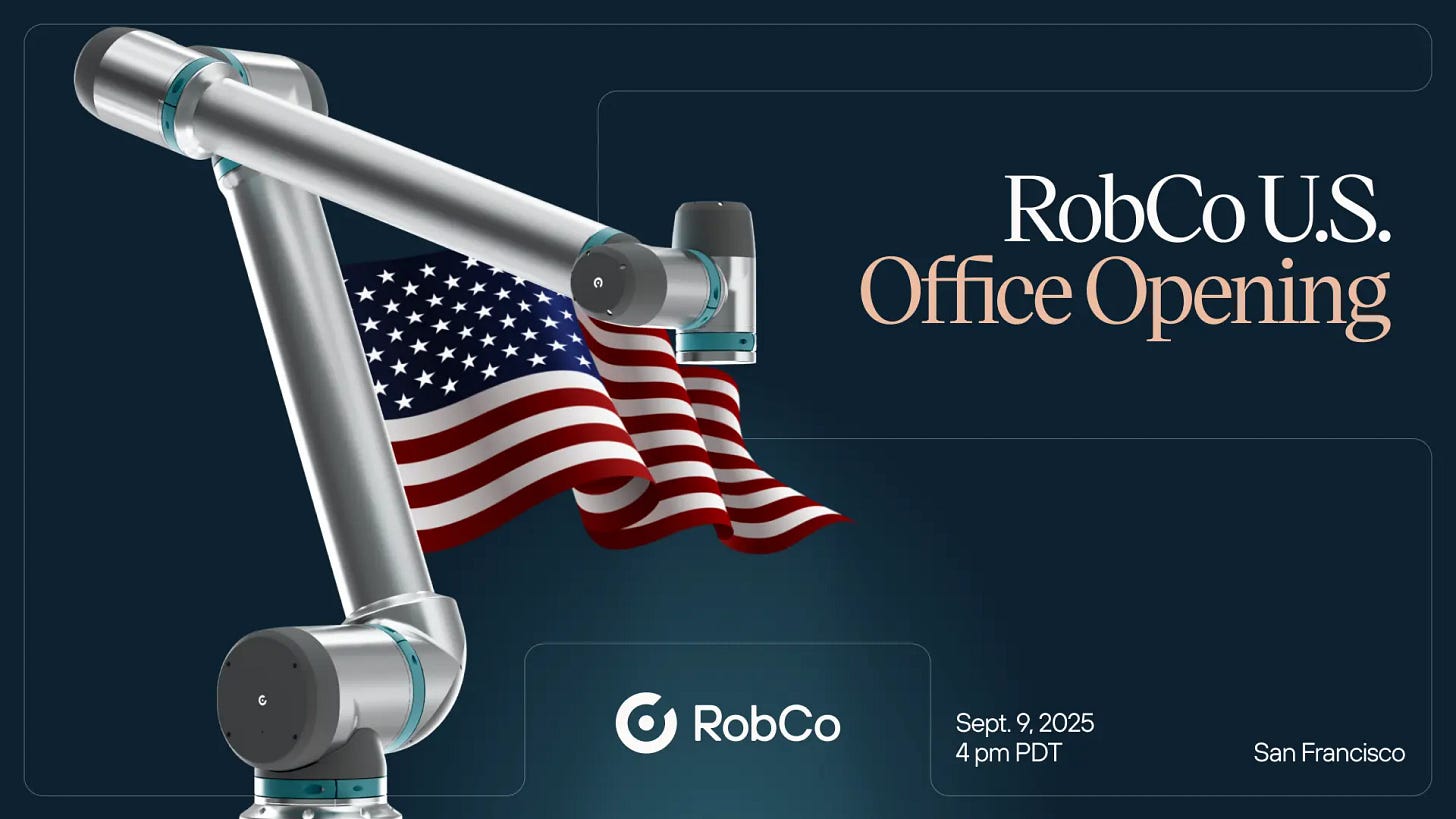EP.75 DANCING ROBOTS ON THE TV
NVIDIA with a chip that will scale up the robotics game, RobCo opens new office in Bay Area, & much more...
Spot dances into the spotlight on ‘America’s Got Talent’ 🕺🏼
Boston Dynamics’ robot dog Spot made its debut on America’s Got Talent, where five units performed a synchronized dance to Queen’s “Don’t Stop Me Now.” They used their robotic arms mounted on the Spot robots for lip-syncing.
One robot collapsed mid-show, but the others adapted instantly, dancing around it without missing a beat, a feature Boston Dynamics programmed for fault recovery. The performance earned four “Yes” votes, sending Spot through to the next round.
Behind the scenes, the choreography relied on Boston Dynamics’ Choreographer software, which lets users drag-and-drop dance moves into routines.
The TV debut was a reminder of Boston Dynamics’ bigger vision: robots that aren’t just tools, but companions capable of fitting into OUR culture.
I enjoyed this one! Take a look.
NVIDIA puts Jetson Thor “Robot Brain” on sale! 💰
NVIDIA has launched its latest robotics module, the Jetson Thor, now available as a $3,499 developer kit shipping next month. Marketed as a “robot brain,” Thor is built on their Blackwell GPU architecture and delivers 7.5x the performance of its predecessor, with 128 GB of memory to run generative AI models for humanoids, autonomous machines, and industrial robots.
Once prototyped, companies can buy Thor T5000 production modules at $2,999 each for orders above 1,000 units. NVIDIA already counts Agility Robotics, Boston Dynamics, Amazon, and Meta among Jetson users and has invested in robotics ventures such as FieldAI.
While robotics currently represents just 1% of NVIDIA’s revenue, the segment is growing rapidly, with its combined automotive and robotics unit reporting $567 million in quarterly sales, up 72% year-over-year. Thor also underpins NVIDIA’s Drive AGX platform for self-driving cars, making it a cross-industry platform for embodied AI.
By supplying the silicon and software stack rather than building robots directly, NVIDIA is positioning Thor as the infrastructure layer for the coming wave of humanoids and autonomous systems.
RobCo opens San Francisco office to scale robot leasing in U.S. 🇺🇸
German robot company RobCo is stepping up its U.S. presence with the opening of a new office in San Francisco this month, paired with a manufacturing site in Austin, Texas that will assemble robots for American customers. The expansion comes after RobCo acquired the assets of Rapid Robotics in January, giving it an immediate foothold in the U.S. automation market.
RobCo’s model differs from traditional robot sales: companies rent robots on a subscription basis (RaaS) and only pay when the systems are operational. This lowers adoption risk while accelerating time to value.
Already operating across 14 states, RobCo’s modular robots are being deployed in industries facing a widening labor gap. The company points to 1.9 million unfilled industrial roles in the U.S., projected to reach 3.8 million by 2033, as evidence of the urgency for automation. By taking on repetitive, injury-prone tasks, RobCo says its robots free workers to move into higher-value roles and help manufacturers attract next-generation talent.
Backed by leading investors including Sequoia Capital, Kindred, and Lightspeed Venture Partners, RobCo is positioning its robot-as-a-service approach as the fastest path for U.S. manufacturers to modernize operations and compete globally.
Meme of the week 🤖
Korean startup releases a new humanoid robot 🇰🇷
Korean robotics startup WIRobotics has introduced its first general-purpose humanoid, ALLEX (ALL-EXperience), designed to react to external stimuli with a level of responsiveness closer to that of humans. The debut took place at the Robot Innovation Hub at Korea University of Technology and Education.
ALLEX features a high-degree-of-freedom robotic hand able to sense and adapt to applied forces. Its robotic arm has friction and inertia levels ten times lower than typical collaborative arms, while a gravity-compensated upper body enables safe, fluid motion and precise force control.
WIRobotics said the robot goes beyond mimicking human movement, instead aiming to “experience and respond” to the world in real time. The company plans to evolve ALLEX into a modular platform, offering arms, hands, and control systems either separately or in integrated configurations. Partnerships with RLWRLD, MIT, UIUC, UMass, KIST, and Maxon will support further development of its physical AI and adaptive control systems.
Founded in 2021 by former Samsung engineers, WIRobotics has quickly built a reputation in the wearable robotics space, winning CES Innovation Awards in 2024 and 2025.
BeyondMimic advances humanoid motion 🏃🏽
Researchers have introduced BeyondMimic, an open-source framework designed to give humanoid robots more natural and versatile movement.
The system uses a diffusion-based model trained on motion capture data, enabling a single policy to handle running, jumping, and acrobatics without retraining for each task. Unlike traditional scripted control, BeyondMimic lets robots adapt movements in real time, guided only by cost functions.
A key focus is simulation-to-reality transfer, ensuring that skills learned in virtual environments can be executed reliably on physical robots. By combining generative AI with control, BeyondMimic marks progress toward general-purpose humanoids capable of fluid, human-like motion.




